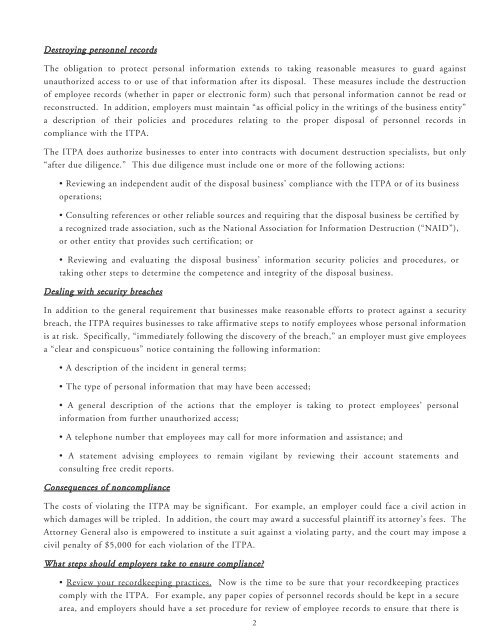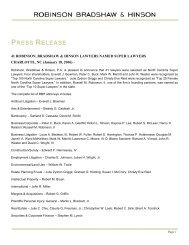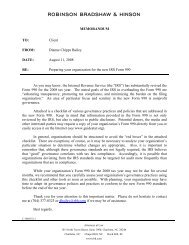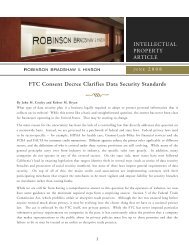Download PDF - Robinson, Bradshaw and Hinson
Download PDF - Robinson, Bradshaw and Hinson
Download PDF - Robinson, Bradshaw and Hinson
You also want an ePaper? Increase the reach of your titles
YUMPU automatically turns print PDFs into web optimized ePapers that Google loves.
Destroying personnel records<br />
The obligation to protect personal information extends to taking reasonable measures to guard against<br />
unauthorized access to or use of that information after its disposal. These measures include the destruction<br />
of employee records (whether in paper or electronic form) such that personal information cannot be read or<br />
reconstructed. In addition, employers must maintain “as official policy in the writings of the business entity”<br />
a description of their policies <strong>and</strong> procedures relating to the proper disposal of personnel records in<br />
compliance with the ITPA.<br />
The ITPA does authorize businesses to enter into contracts with document destruction specialists, but only<br />
“after due diligence.” This due diligence must include one or more of the following actions:<br />
• Reviewing an independent audit of the disposal business’ compliance with the ITPA or of its business<br />
operations;<br />
• Consulting references or other reliable sources <strong>and</strong> requiring that the disposal business be certified by<br />
a recognized trade association, such as the National Association for Information Destruction (“NAID”),<br />
or other entity that provides such certification; or<br />
• Reviewing <strong>and</strong> evaluating the disposal business’ information security policies <strong>and</strong> procedures, or<br />
taking other steps to determine the competence <strong>and</strong> integrity of the disposal business.<br />
Dealing with security breaches<br />
In addition to the general requirement that businesses make reasonable efforts to protect against a security<br />
breach, the ITPA requires businesses to take affirmative steps to notify employees whose personal information<br />
is at risk. Specifically, “immediately following the discovery of the breach,” an employer must give employees<br />
a “clear <strong>and</strong> conspicuous” notice containing the following information:<br />
• A description of the incident in general terms;<br />
• The type of personal information that may have been accessed;<br />
• A general description of the actions that the employer is taking to protect employees’ personal<br />
information from further unauthorized access;<br />
• A telephone number that employees may call for more information <strong>and</strong> assistance; <strong>and</strong><br />
• A statement advising employees to remain vigilant by reviewing their account statements <strong>and</strong><br />
consulting free credit reports.<br />
Consequences of noncompliance<br />
The costs of violating the ITPA may be significant. For example, an employer could face a civil action in<br />
which damages will be tripled. In addition, the court may award a successful plaintiff its attorney’s fees. The<br />
Attorney General also is empowered to institute a suit against a violating party, <strong>and</strong> the court may impose a<br />
civil penalty of $5,000 for each violation of the ITPA.<br />
What steps should employers take to ensure compliance<br />
• Review your recordkeeping practices. Now is the time to be sure that your recordkeeping practices<br />
comply with the ITPA. For example, any paper copies of personnel records should be kept in a secure<br />
area, <strong>and</strong> employers should have a set procedure for review of employee records to ensure that there is<br />
2





